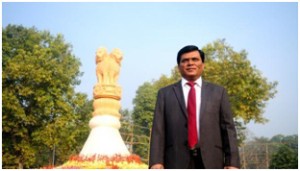Dalit capitalism’s moment has arrived
 When Dalits in prosperous states start agitating against occupations such as clearing garbage and tanning, India’s mask of social harmony starts to slip. Dalits facing physical violence are speaking up, as with a young Dalit boy attacked recently in Bhavra village, 40 km from Ahmedabad, because his family had decided to boycott the work of lifting dead carcasses. They are increasingly asking for basic rights — the right to land, the right to public goods and spaces like water and temples, and the right to social acceptance. Other Dalits in Saharanpur’s Usand village in Uttar Pradesh have taken to sleeping in the forest, given the concerns about physical safety. Municipal corporations around India are suddenly starting to run out of willing Dalit workers to sweep the floors and remove carcasses. Social justice, an age-old topic, is the new third rail.
When Dalits in prosperous states start agitating against occupations such as clearing garbage and tanning, India’s mask of social harmony starts to slip. Dalits facing physical violence are speaking up, as with a young Dalit boy attacked recently in Bhavra village, 40 km from Ahmedabad, because his family had decided to boycott the work of lifting dead carcasses. They are increasingly asking for basic rights — the right to land, the right to public goods and spaces like water and temples, and the right to social acceptance. Other Dalits in Saharanpur’s Usand village in Uttar Pradesh have taken to sleeping in the forest, given the concerns about physical safety. Municipal corporations around India are suddenly starting to run out of willing Dalit workers to sweep the floors and remove carcasses. Social justice, an age-old topic, is the new third rail.
At an individual level, Dalits continue to remain significantly poorer than other social classes — 36% of the rural Dalits are classified as poor while just 13% of the SC men are engaged in regular salaried work, despite public-sector affirmative programmes.
The government can help nudge social behaviour and institutions to encourage Dalit empowerment. Consider education. According to the 11th Five-Year Plan, dropout rates continue to be high — 74% of the Dalit boys and 71% of the Dalit girls usually drop out of primary and secondary school.
Incentive schemes, such as free textbooks or free hostel accommodation in universities for students from underprivileged households, can go a long way in overcoming the barriers of poverty and discrimination. Offering such students access to the minimum facilities (a bed, a table, a chair, etc) can help make education more inclusive and incentive-focused.
There are only a few Dalit entrepreneurs in India, with most Dalits still employed in their traditional occupations. Such individuals would also lack access to social enablers — only 12% of the Dalit households have access to 2-3 contacts in the formal sector, compared to 26% amongst the forward castes. Given the discrimination, a history of landlessness, social pressure and little, if any, relevant sub-caste networks, Dalit businesses are few and far between.
Enabling the launch of more social impact funds focused on Dalit entrepreneurs (e.g.: Dalit Indian Chamber of Commerce and Industry) can help solve financing issues, with a special focus on fiscal incentives and infrastructure support.
The growth of grassroots cooperatives/institutions for developing traditional crafts presents a solution. The Urmul Marusthali Bunkar Vikas (UMBV) has provided 120 Dalit weavers of the Meghwal community with sustainable livelihood through their traditional crafts, stopping migration and keeping local skills alive.
We need to make it easier for Dalit businesses to flourish. The Dalit presence in businesses has stagnated — 9.9% in 1990 and 9.8% in 2005. Since 1989, the National Scheduled Castes Finance and Development Corporation has disbursed an average of $484 per borrower to over 900,000 Dalits. The empowerment of small and medium enterprises, through incentives for struggling entrepreneurs, remains the right way to bolster SC/ST entrepreneurship. An expansion of the Public Procurement Policy’s mandate of 20% from SME businesses, as part of the Stand Up India campaign, could bolster Dalit suppliers. Dalit capitalism’s moment has arrived.
Fair land distribution corrects unequal social constructs and power equations by providing equal access to productive economic units. Land reforms (tenancy, land ceiling, consolidation of holdings and intermediary abolition) have produced mixed results, especially where land distributed remains on ‘paper’ — land distributed is not land owned for many Dalits. Physical occupation of lands needs to be ensured, through social audits at the gram sabha level, under the guidance of a Special Expert Committee under the SC Commission, supported through awareness generation through camps.
We need to recognise the need for land reform as well to induce equity for Dalits in agriculture. The government of Andhra Pradesh has launched a crash programme since 1969 to assign government waste land to the landless poor people, particularly the Dalits. Over 113,972 acres was distributed to 43,000 beneficiaries under the Bhoodanland programme.
Our society is marching from feudalism to post-modernism, in less than a generation; and yet outdated attitudes remain. While the media continues to highlight the plight of the Dalits, one must stand vigilant against reducing such livelihood issues to a by-line. We’ve spent the last half-century pitting our castes against each other, in politics and in the job market. Leaving such islands of inequity, in India’s journey towards development will only give rise to social turmoil. For Dalits, equity and social acceptance must go hand in hand.
Source: Hindustan Time





